THC is lucky enough to have an ex-KCL Wargame Studies lecturer amongst its guest contributors. Today, Arrigo Velicogna sings the praises of a solitaire board wargame that’s chock-a-block with Churchill tanks, chary Jerries, and chancy counterattacks.
In this column I have already explored several, okay two…, solitaire wargames. While these games were quite different from each other, they had in common an aversion to hexes and ground combat. Does this mean that solitaire wargames, at least the ones using analogue rather than digital components, must eschew hexes and terrain?
The simple answer is no. Some of the icons of the genre, games like Carrier and Ambush (the Velicogna Verdict will explore them sooner or later), were not afraid of hexes. The latter also successfully tackled ground combat. Wargames designed for face to face or solitaire play come in every shape and size. More to the point they have access to an overwhelming repository of techniques. These techniques certainly include hexes.
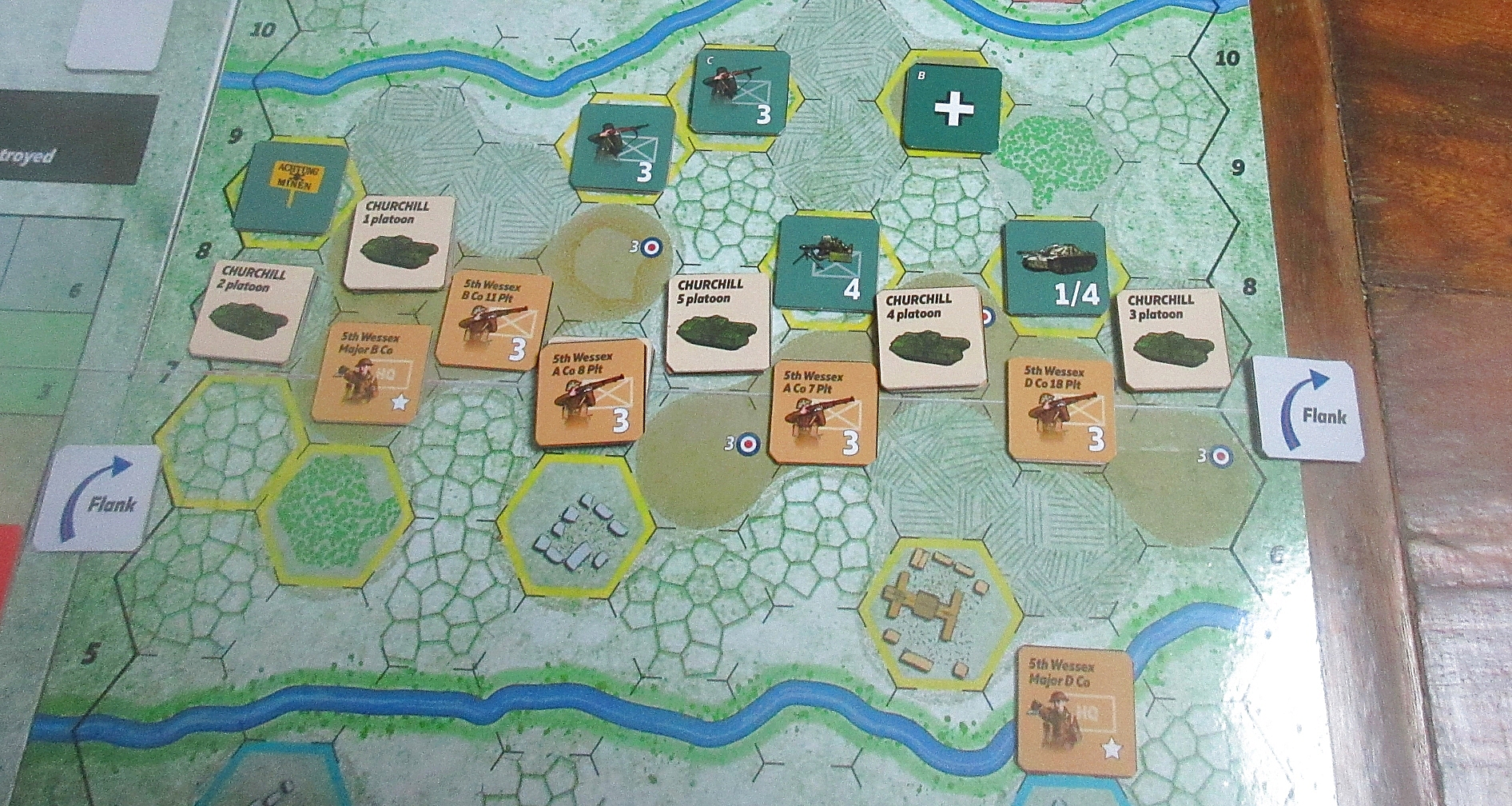
Stout Hearts from Tiny Battle Publishing (disclaimer: I know the publisher and also work with them, but in no way has this influenced the review) tackles battalion level command and combat in war-torn Normandy. It relies on counters and a hex map, eschewing cards and other fancy ‘innovations’. The 11 x 17” map represents a typical slice of countryside in the British sector. There is only one map in the game. The terrain is fixed. We will discuss later if this is a drawback. The map itself is a clear depiction of the various terrain encountered in this corner of Normandy. It is also nicely done. The platoon sized counters are large (very large) and feature standard NATO icons, unit-appropriate illustrations, and combat values. They are one-sided for the player side (the British Army), while they have hidden and revealed sides for the Germans.
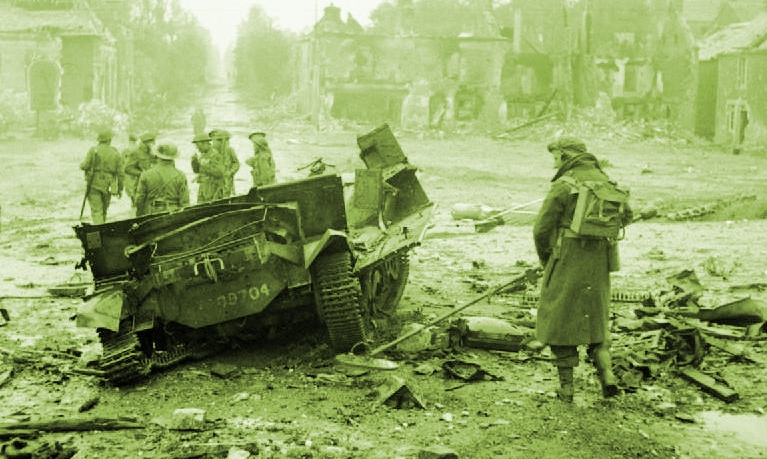
You can find all the usual suspects amongst them, from German Panthers to British Bren Carriers. There are also plenty of informational markers. Completing map and counters, you have table, a 11×17” battalion command display and, obviously, rules. The rules are short, but reasonably clear. There are examples and designer notes.
So what exactly is the game about? You are the Lieutenant Colonel (referred to as half-colonel in British Army jargon) in command of a fictional infantry battalion, the 5th Battalion of the Wessex Regiment. Your task is to break through German defences in a typical brigade sized attack in the summer of 1944.
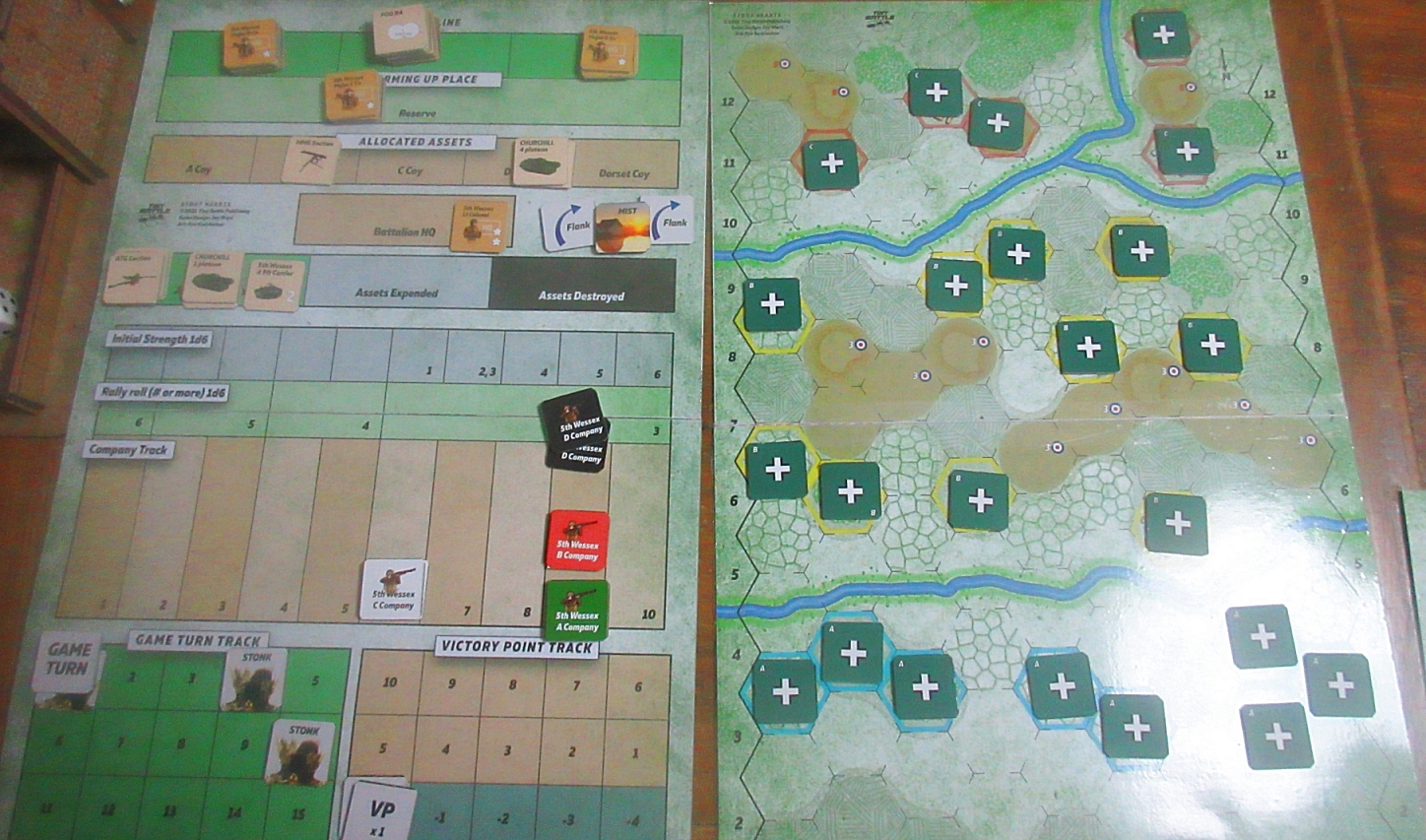
The Germans have three lines of defence in your sector. An outpost line, a main line (the HKL), and a reserve position. The various strongpoints of these lines are printed on the map. For each line there’s a corresponding cup filled with German units ranging from inconsequential scares (bushes moved by the wind…) to decidedly consequential tanks. Each line has an appropriate mix of troops giving a sense of purpose to the Germans. Another ingenious element is the way some German units get recycled to different cups when removed from the map, (this mechanic represents the delaying role of the outpost line).
On your side you have four line infantry companies, an attached company of 15 Churchill tanks, and your battalion assets. The latter consist of MGs, AT guns, engineers, and Carriers (as in Bren Carriers, not aircraft carriers). You have also mortars (organic), and divisional artillery support. Your companies have been in Normandy for quite some time, thus at the start of the game you roll to see their current strength. The strength not only determines how many casualties they can suffer in the game, but also how easy is to rally the platoons once they get stopped and become static (see on). Worn out units are not just weaker, but you must be careful with them because they are brittle.
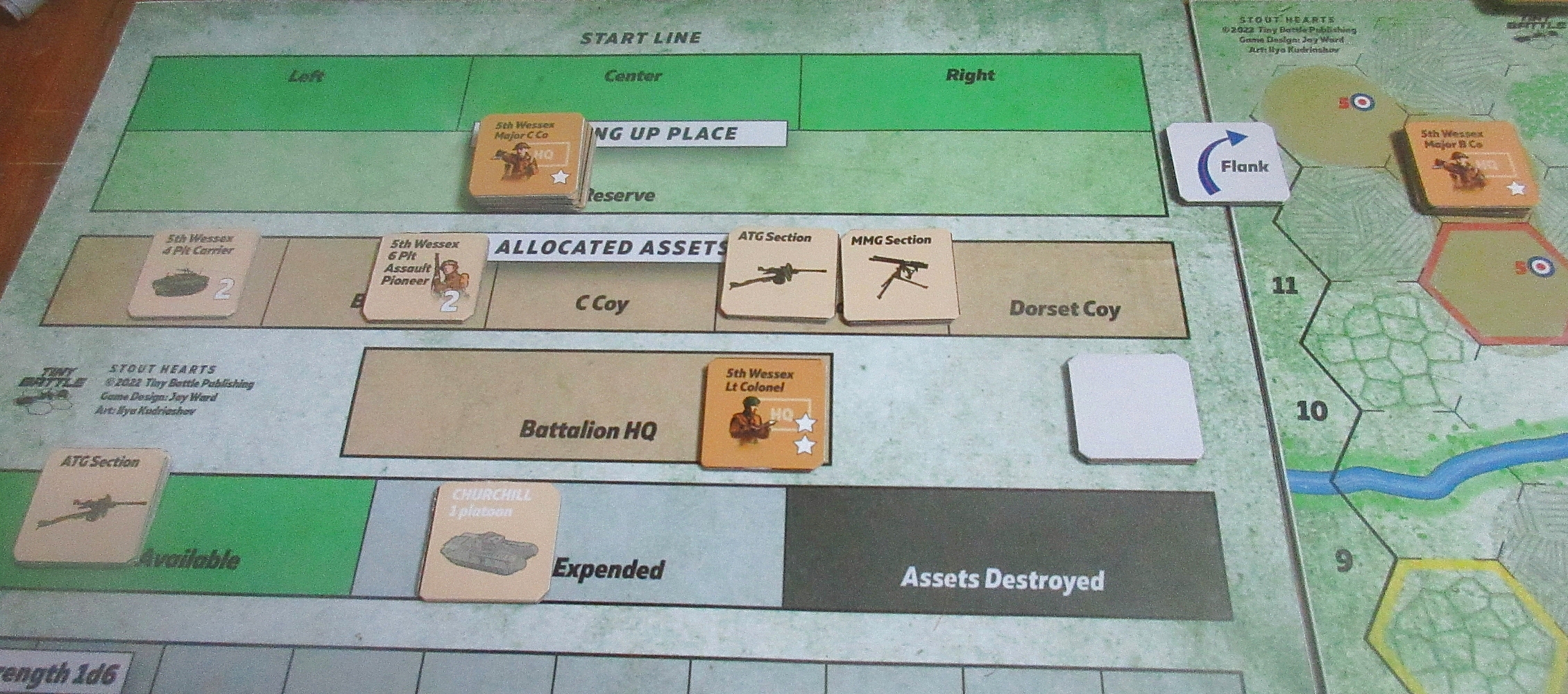
‘Active’ and ‘static’ are key concepts in the game. Active units are fully operational and follow (more or less) the player’s wishes. Static units are, as the name suggests, static and cannot do anything except defend until rallied. This reminds me of Phil Sabin’s idea of fresh/spent, but here the concept is executed in a much more satisfying way. Static units still have some abilities, albeit reduced. The other key element is the difference between combat units (infantry platoons) and assets. The latter cannot operate without being attached to the former, and provide invaluable support. For example Churchill tanks provide protection and firepower (doubling the combat power of the units they are supporting). Engineers (Assault Pioneers) increase combat, especially against buildings, and improve mine clearance). Thus assets are more than just numbers. They represent specific capabilities.
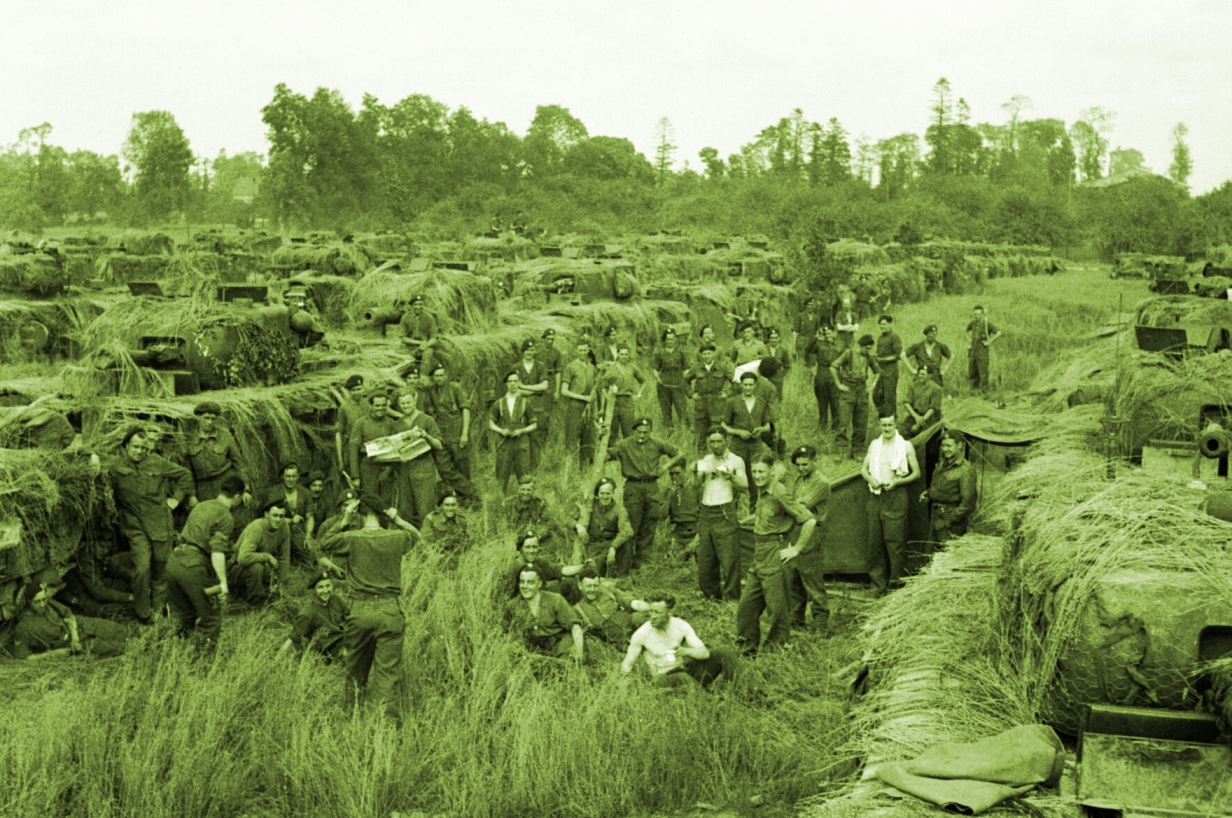
Assets must be allocated to your companies before being used. Stout Hearts is game where planning is essential. Before the game starts you have to go to your battalion deployment board and assign roles (left, centre, right, and reserve) to your infantry companies and allocate assets. Remember these assets are finite and reallocating them cannot be done on the fly. Deciding what you want to accomplish and how to go about it is critical to success. Bear in mind that these assets can become static too, or even be eliminated. Assets can also be kept in reserve at company or battalion level. This will allow you to deploy them were needed in a much quicker way during the assault, but, conversely, you will not have them in for the initial round.
I found the whole assets management a key, if not the key, component of the game, and a very good way to put you, the player, in the shoes of the Battalion Commander. Mastering the needs of the initial push with the necessity to keep an intact force for reviving stalled attacks or exploit success is an art difficult to master. It is also something that come to the fore in reading After Action Reports. The art of battalion command is not so much manoeuvring platoons, but coordinating them in a battalion whole, and having an unengaged reserve. Remember, as General Sharp (British Army, Retired) is fond of saying “something assigned to a task is not a reserve”.
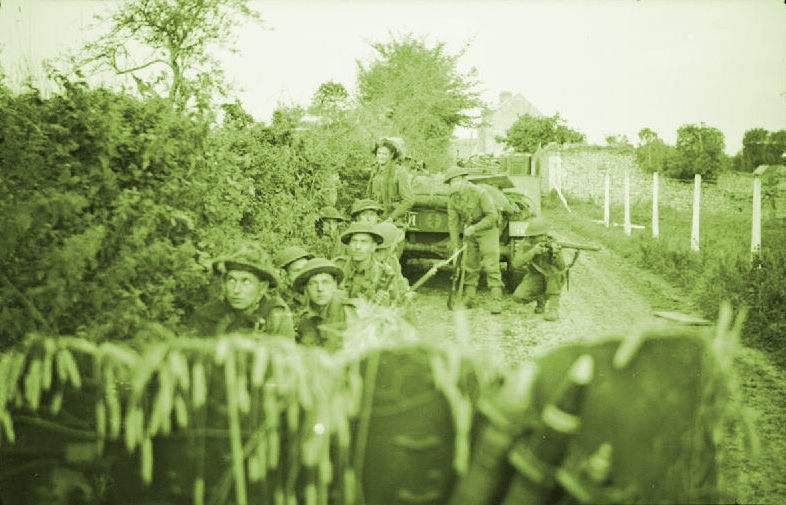
Another key element is the slowness of movement under threat. I said ‘threat’ rather than ‘fire’ because even unrevealed and inactive German units exert influence on your forces. Unrevealed units are even worse in this regard. Jay Ward, Stout Heart’s designer, has expanded the usual ZOC (Zone Of Control) concepts to something more intriguing. German ZOCs exist within a three hex range of an unsuppressed German position. British units inside this area that can be seen by the German position can move a single hex. Furthermore, moving within two hexes of an unsuppressed position also forces your unit to take a test that can result in your unit becoming static. This neatly shows the difficulty of attacking across exposed terrain, and the inherent slowness of such attacks. Suppression fire, artillery, and smoke become essential elements of a sound tactical approach. Conversely once enemy units are revealed they became known, and their effects depend on the type. There are two ways to reveal a German unit. First you move adjacent to it. Second you roll to see the effect the unrevealed unit has on your movement. And before you think sneaking close to the Germans is scot-free… your platoons are obliged to assault adjacent German positions. Unprepared assaults against unknown positions tend to be dangerous. A sensible assault requires suppressing the enemy with fire (indirect or direct) and having the right mix of capabilities. Because they take time to set-up and are prone to disruption, attacks can be bloody, slow, or both!
Another element you must consider is timing. You, as the battalion commander, are operating as part of a brigade. Your brigadier has a timetable. If you fall behind it, you will be penalized in victory points (read final evaluation). This provides an incentive to push forward even if, at times, your natural instinct is to be more conservative. Dilly-dally too much on the outpost line and fail to make a dent in the HKL and the brigadier will be upset. More to the point you have battalions advancing on both your flanks that you must maintain connections with. At the end of each turn both flanking battalions will test their advances. If they are beyond your flanking units, you will lose victory points (read: their COs will complain about you leaving their flanks exposed). You cannot simply push on a narrow front bypassing pockets of resistance. You are part of a brigade advance.
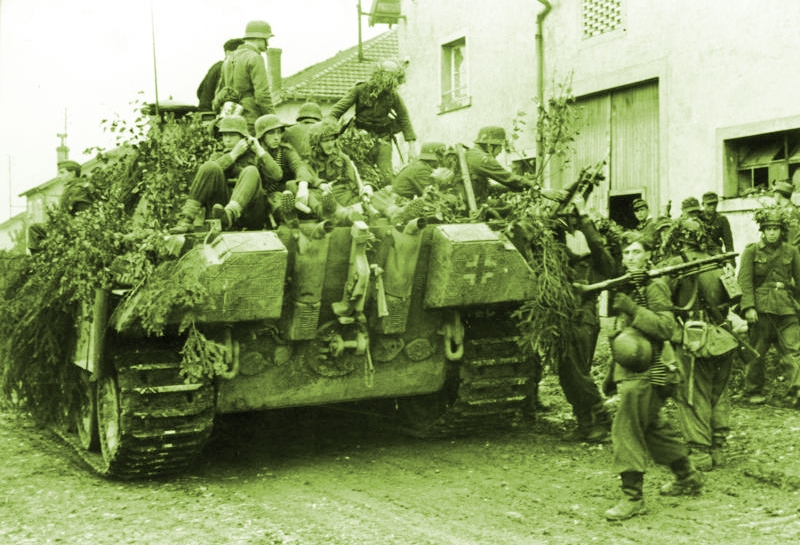
Finally, there are the Germans. Not only do their defensive positions and units slow you down and their guns engage your vehicles, but each time you take a defensive position there is a chance they will counterattack. It is a random chance but, of course, counterattacks become more and more likely as you push deeper. These ripostes can be attacks by fire with mortars, or, worse, proper counterattacks aimed at retaking a position. All this contributes to making your German opponent feel realistic and alive.
Personally, I much prefer systems where enemy reactions are variable and their position unknown. Once my mentor, Professor Phil Sabin, complained that hidden units in a solitaire game make it too luck dependent. Often people complain about luck in wargames and the inability to precisely plan in advance. Stout Hearts makes you reflect again on Eisenhower’s adage: “Plans are useless, planning is essential”. I would argue that Stout Hearts not only provides replayability through mixing units and action tables, but does ‘Fog of War’ right. The enemy is hidden in nature, but you have a rough idea of their positions. The enemy capabilities vary between plays. Each German pool has more units than available positions. These pesky Panthers will not appear every time, but may show up when you least want them. The counterattack table also introduces pleasing variation. The enemy will not attack you every time you take one of their positions, but there’s always that possibility. It’s vital to consider these unknowns when pondering and when executing a plan.
The system also recreates the nature of the German forces at the time rather nicely. The constricted terrain forced them to rely on infantry – more often than not their supposedly mobile panzergrenadiers – in static positions, stiffened by a handful of heavy weapons and tanks (or assault guns). It was not that the Germans had too few of them, actually, it could be argued that they had too many mobile forces and too little infantry, it was that the terrain forced them to do that. Massing panzers was usually a bad idea because it just jammed them in small spots lacking room to manoeuvre. Both Guderian and Fritz Bayerlein complained about the wastage of their precious panzers in attacks. Yes in defence, a handful of panzers were redoubtable, but it was not what they were designed for. German doctrinal defence is also considered with their penchant for outpost lines to break up enemy advances and then a main line to stop them. In this regard the system is also helped by the fact that it simulates only defensive operations, albeit still showing the Heer penchant for counterattacks.
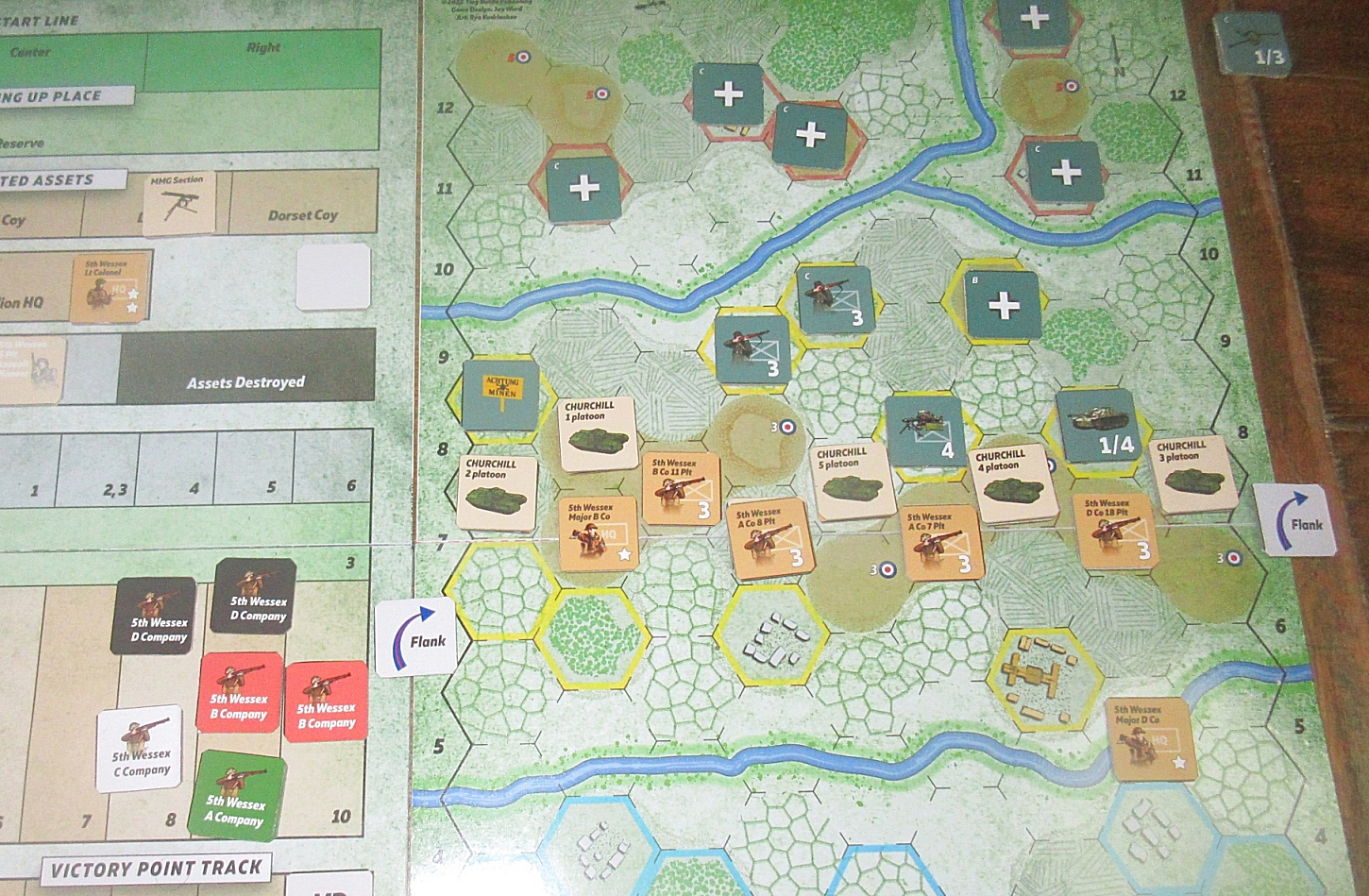
Stout Hearts succeeds in putting you in the boots of a battalion commander in Normandy. You are given realistic resources and realistic expectations. The solitaire system manages to produce plausible results and the twists and surprises necessary for replay. Information is easy to access and the rules are logical. At the start I was slightly worried about replayability due to the single map and fixed British forces. Yet, it turns out that these are not limiting factors. The map might be the same every time, but the German defenders are not. Your battalion will vary in strength, and sometimes supporting assets do not show up instantly. While victory is ‘just’ based on accumulating victory points, these points represents real world concerns. Victory is not simply rushing to the objective or killing the enemy, but playing your part in a larger scheme. At times, yes, you will feel unfairly treated by the system – unjustly penalised for not doing things you deemed idiotic at the time – but resenting the unreasonable demands of higher-ups isn’t exactly inappropriate given the subject matter.
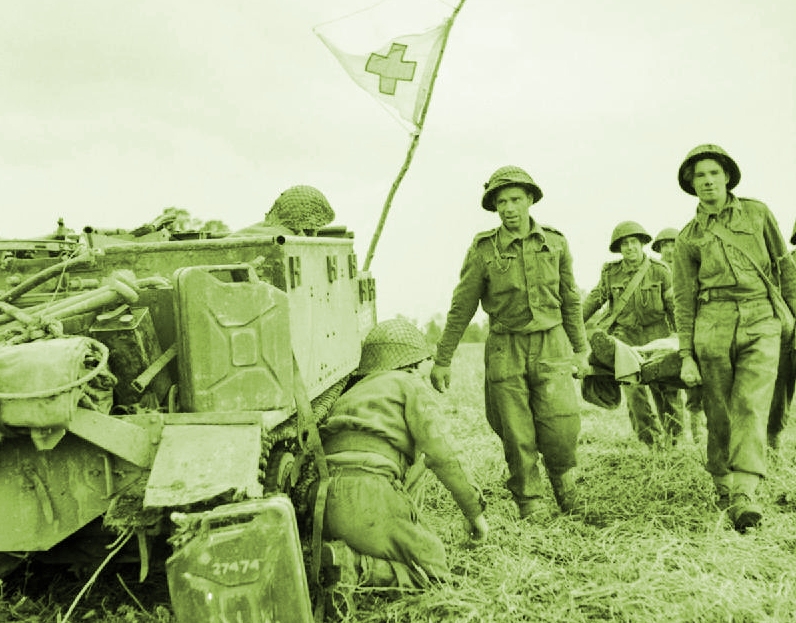
Squandering your battalion will not earn you accolades, but at the same time the game makes you realize that, to a certain extent, in a campaign such as Normandy even battalions are expendable as long as results are achieved. Despite all the glamour surrounding it, the D-Day invasion was essentially a campaign of bloody attrition. Yet despite all the aversion attrition generates, it is an essential and unavoidable element of war. Victories tend to be bloody, bloodless, brilliant manoeuvres wishful flights of fancy. Yes, here we’re shepherding cardboard counters not real men. But while free of graphical gore, chance are Stout Hearts will still cause you to think about War’s grim bottom-line.
In conclusion Stout Hearts is a good, no, an excellent game, with thoughtful rules and realistic mechanics. It crams a hefty history lesson into a small footprint.

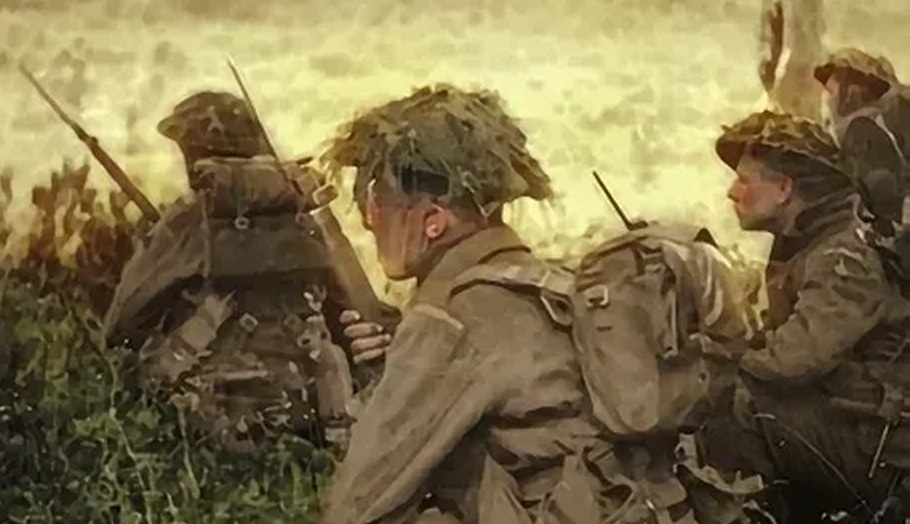
Before this disappears off the front page, I just want to say that this is a wonderful review. Very intrigued by the way it represents/evokes the ideas you describe in the closing paragraphs. Bit of a shame it’s almost double the price over here in Europe compared to the U.S.! Not the publisher’s fault, I imagine, but $32 is a much easier buy than 50-odd euros.
Having said that, the downloadable PDF is available for $15 – could definitely be worth a print and play.